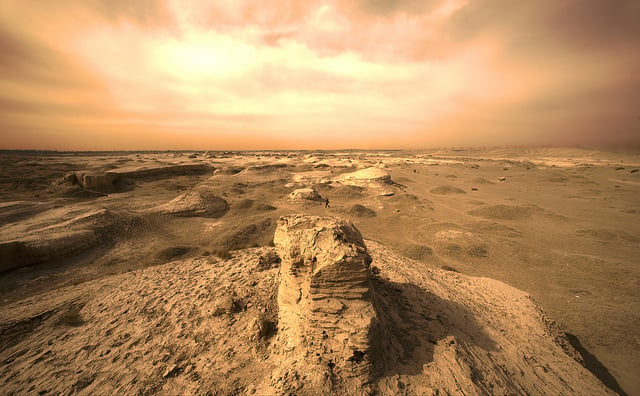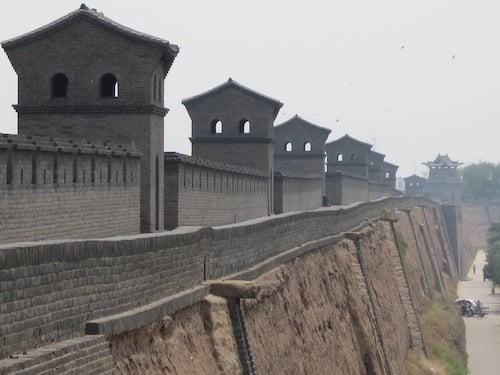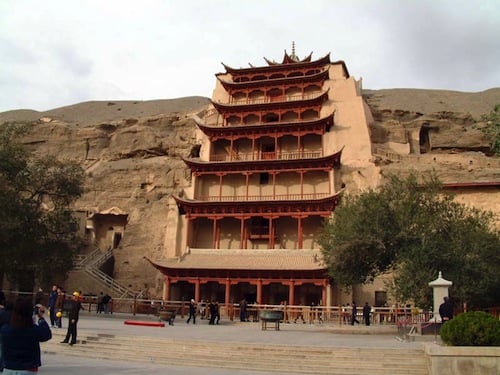
The Silk Road has come under scrutiny in the media recently, as a hub of illicit trade. In this adventure we will not be diving into the world of underground narcotics, but instead across Persian deserts and mountain passes on a route that traverses two continents from eastern China to Istanbul.
This historic route linking China to Europe has been used be travelers, traders and pilgrims for over two milennia. It gave birth to a wide range of culture and ethnicity, beheld great riches and was home to many bandits. Journeying along the Silk Road in the modern day is coveted, as the region is perhaps the most strict and perilous place on the planet. The traditional route passes through Bagdad, traverses Kyrgyzstan and Tajikistan who recently outlawed Father Christmas from being broadcast on TV. Very much autonomous states with strict entry requirements. Have I made it sound appealing yet?
Some of the magnificent landmarks along this historic trail include:
- 1500 year old sandstone buildings in the desert
- Magao Caves
- The Great Wall of China
- Xian Terra-cotta Warriors
I want to now take you on a journey two of the most accessible countries on this trail, Turkey and China.

Xian Wall. Photo courtesy of William Cecil.
Xi’an
The trail has been heralded by many as beginning in the ancient capital of Xi’an, home to the Terracotta Warriors. These soldiers were buried 200 years before the birth of Christ in order to protect the first emperor of China, Qin Shi Huang, in the afterlife. Our Chinese itinerary will begin here. Getting to Xian is relatively easy from anywhere in the world, it’s home to two international airports and has a good train service from Beijing. When traveling to China it’s worth buying tickets 6+ months in advance, as while comparing air fares you will notice huge disparity in prices, more so than many other destinations. Many of the Terracotta Warriors are housed within a museum 1.5 kilometers (09. miles) from the burial mound of Qin Shi Huang. Up to 40,000 visitors a day visit the excavation site, so it’s advised to arrive early and avoid the mid-day rush.
Xi’an has over 3,000 years of history and heritage to it’s name. Fifteen hungred years ago after the establishment of the Ming dynasty the Emperor at the time decided to fortify Xian, which occurred during the period of the Tang Dynasty. It remains today as the largest ancient military defense system in the world. As this wall engulfs the city it’s hard to miss it, standing at 40 feet (12 meters) high and has a moat 120 feet (37 meters) across. Tours are open to parts of the ramparts, with reenactments of what life would have been like in the watch towers which are situated 394 feet (120 meters) apart. This is just enough so from either side arrows could be shot at perpetrators trying to invade the city.

Mageo Caves. Photo courtesy of William Cecil.
The Magao Caves
Our next stop on the Silk Road are the Magao Caves which are 932 miles (15,00 kilometers) to the northwest of Xian in the Provence of Gansu. The caves are home to a series of 492 Buddhist temples, which were the product of trade along the road and ultimately formed a religious and cultural crossroad. Some art work on the walls is almost 2,000 years old. According to Tang Dynasty records a monk traveling along the road witnessed a vision of a thousands Buddhas under a shower of golden rays. This prompted him to pay homage and set up a temple. As more and more travelers and pilgrims came through the area, the number of temples grew.
Some of the temples reach 100 feet (30 meters) high and some as little as 2 inches (5 centimeters). The best way of getting to the region from Xian is via train to the town of Dunhuang. The train takes around 10 hours, so to avoid the sweltering heat and a day of wasted holiday it’s advisable to take the sleeper. There are 83 hotels within the city, some of which are themed in converted accommodation the travelers on the Silk Road would have stayed in.
Westward from Dunhuang in the summer is home to a baron desert region, and in the winter intense cold with the average daily temperature -10 degrees Celsius (14 degrees Fahrenheit). There are quite a few tours into the desert via camel, led via locals.

Maidens Tower in istanbul. Photo courtesy of William Cecil.
Istanbul
The next step of our Silk Road adventure is Istanbul, which is one of the four typical destinations Silk Road traders would have ended their journey and sold/traded their goods. Istanbul is still regarded at the hub of the Persian commerce, allowing the legacy of the Silk Road to live on.
Istanbul today is still the major road and rail link between the Middle East and Europe. Our tour of the city starts on the eastern banks of the Bosphorous. It’s easy to get to and can even be accessed via the new underground road network flowing under the strait.
From here you should head toward the Maidens Tower. It’s on a small islet, and is a 2,500-year old building which has seen empires from the Romans to the Ottomans. It’s home to many legends, most notably the legend of the snake, in which an oracle prophesied a snake would kill the Emperor’s daughter on her 18th birthday. The Tower was built so snakes would never be able to reach her unless she was confined to the island. Nonetheless, a basket of fruit was given to her on her birthday and a snake had concealed itself in it, leading to her demise. If you’re a fan of legends, lore and fantasy then this islet is perfect.

Aromatic spices at the Grand Baazar. Photo courtesy of Jessica Festa.
The Grand Bazaar
So far we’ve not seen any trade, so to go back to Istanbul’s foundations no trip would be complete without a trip to the Grand Bazaar. It’s one of Europe’s largest and oldest covered markets. Set up in the 15th century, this marketplace still receives over 300,000 visitors daily and sells everything from silk and gemstones, to spices and furniture.
Many of the local craftsmen you see in markets across Europe will have sourced textiles and materials from dealers located in the Grand Bazaar. So you can get unique items at a hugely discounted price should you be good at haggling. There are four entrances, taking you into either the textile, jewel, furniture and leather sections. The best way to enjoy the market is to enter through the Nuruosmaniye gate which is the most elaborate, topped with a gold leaf. The architecture has changed since it’s inception and a great fire in 1700 caused the rebuild to be in stone instead of wood.
The Silk Road is home to some incredible sights and history. China and Turkey are the two easiest countries to visit, however, if you’re more adventurous then you need to visit, Iraq, Iran and Turkmenistan.=
Contributed by guest author William Cecil.
Top photo: Desert in Gansu. Photo courtesy of Jonathan Kos-Read.

Jessica Festa is the editor of the travel sites Jessie on a Journey (http://jessieonajourney.com) and Epicure & Culture (http://epicureandculture.com). Along with blogging at We Blog The World, her byline has appeared in publications like Huffington Post, Gadling, Fodor’s, Travel + Escape, Matador, Viator, The Culture-Ist and many others. After getting her BA/MA in Communication from the State University of New York at Albany, she realized she wasn’t really to stop backpacking and made travel her full time job. Some of her most memorable experiences include studying abroad in Sydney, teaching English in Thailand, doing orphanage work in Ghana, hiking her way through South America and traveling solo through Europe. She has a passion for backpacking, adventure, hiking, wine and getting off the beaten path.








